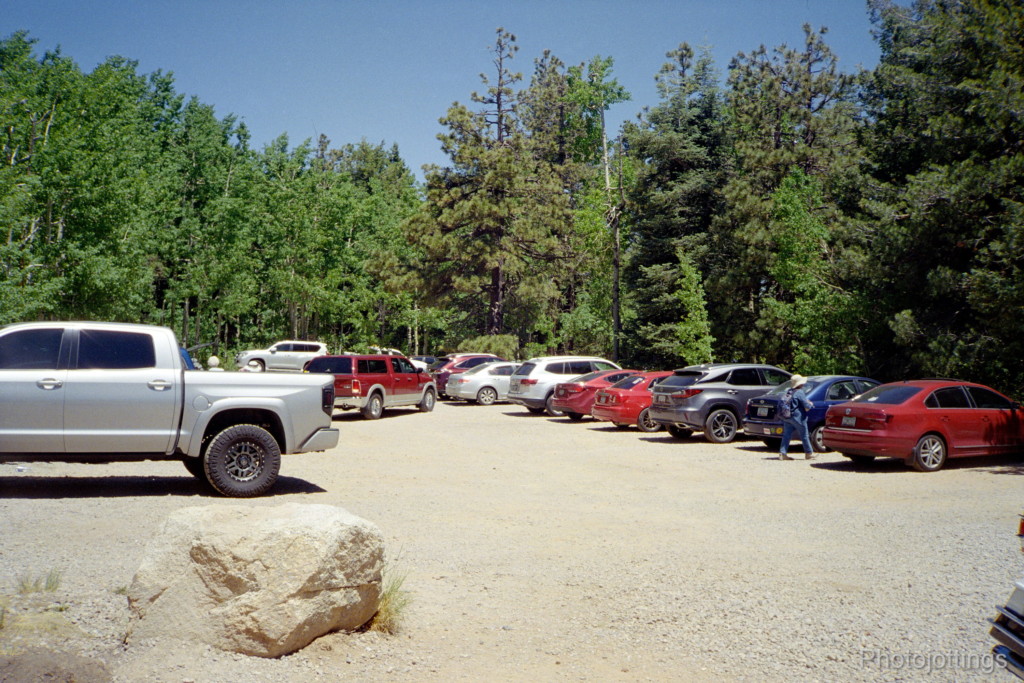
Today we review the Minolta Weathermatic 35DL, an all weather camera that’s sealed for diving to depths of 16′ (5m). However, with the o-rings being over three decades old, I think we’ll skip the underwater part of our review, and head for the high (and dry) country for our test photos.
Although Minolta markets the Weathermatic 35DL as having a ‘dual lens,’ it really has only one lens, but uses a ‘dual’ focus design, which varies the amount of space between lens groups to achieve two different focal lengths, 35mm and 50mm. Other features include DX coding, AF above water, close-up setting, two choices of batteries, and a surprisingly quick recycling flash. As a side note to the power requirements; the owner’s manual says you can use either a CRP2 6 volt, or 4 AAA batteries, however, my copy does not have the right configuration for using AAA batteries.
One other feature worth mentioning is this camera feels really good in my hands, and is probably the most ergonomic 35mm camera I’ve ever held due to the contoured right hand grip and slightly raised ‘grab’ bar on the left hand side.
With the pleasantries out of the way, let’s take a look at the Minolta Weathermatic 35DL specs.
Name; Minolta Weathermatic 35DL.
Box contents; I think it came in several different combinations, camera only, and possibly as the kit you see above except you’d get a small carrying case instead of the large pouch, or maybe no small pouch, I’m not sure.
Manufactured by; Minolta Camera Co, Osaka, Japan.
Date of manufacture; 1987-?
Made in; Malaysia.
Price; an October 1989 Popular Photography magazine ad lists the camera price at $164.95, the ‘sports’ finder at $14.95, and the case at $24.95. Price sticker on Camera Box from Lechmere Dept Store in Boston says $229.99, date unknown. Current ebay prices are around $15-$50 for a good used copy, more with the box and accessories. I paid $19 for my copy with accessories pictured above at a thrift store.
Other versions; the Minolta AF-DL is the same basic camera in a different shell. The Weathermatic ‘A’ is in 110 format, and the ‘Vectis’ is in APS format, all have yellow bodies.
Build material; thick plastic housing with back cover Gasket, and O-ring seal on the battery compartment. Sealed glass housing over lens.
Weight; camera only, 15.02oz (430g).
Dimensions; Size is 5.9″ (148mm) wide, 3.15″ (80mm) high, and 2.6″ (67mm) deep.
Focal length; 35mm, and 50mm.
Aperture; maximum F/3.5 at 35mm, and F/5.6 at 50mm, unknown minimum aperture.
Focusing; above water: infrared active type autofocus, 2.5′ (0.75m) to infinity. Close-up from 1.7′ (0.52m) using 35mm lens, and 2.0′ (0.62m) using 50mm lens. Underwater: fixed focus, 4.0-11.8′ (1.2m-3.6m) using 35mm lens, and 4.3-10.5′ (1.3m-3.2m) using 50mm lens. Close-up button from 1.7-4.3′ (0.52m-1.3m) using 35mm lens, and 2.0-3.3′ (0.62m-1.0m) using 50mm lens.
Original print size; standard oversize prints 4″ x 6.
Approximate resolution; will make excellent 5″x 7,” and good 8″x 10″ prints.
Lens; Dual focusing design which changes the focal length; 35mm F/3.5, and 50mm, F/5.6.
Shutter and speed; variable shutter speeds, I couldn’t get any longer speeds than about 1/30s. No cable release option.
Distortion; looks mild from the pictures I have with straight lines near the edges.
Color fringing; mild magenta colored lateral type.
Double exposure prevention; yes.
Film; all 135 film cartridges, B&H, Amazon, eBay.
Flash. electronic strobe, fast recycling of just over one second with CRP2 (223A) battery, and just under two seconds using four AAA batteries. Flash always fires when close-up button is used.
Power; expensive 6 Volt CRP2 (223A) battery, or four common AAA batteries according to the owner’s manual. For some reason, my copy will not take AAA batteries.
Viewfinder; somewhat small with decent brightness, neutral color, guidelines and parallax marks.
DX coding; ISO 100, and 400 only. Defaults to ISO 100 when no code is detected. Automatically sets ISO to 100 if DX code is less than 400, and ISO 400 when above ISO 400.
Accessories for this model; cloth pouch, sports finder, carrying case and film holders, all colored yellow.
Crippling features and omissions; fully automatic exposures, and no compensation; for use in bright light above ground, and defaults to flash at close distances and underwater.
Good features; decent dual focusing lens, quick flash recycling, and nice ergonomics for people with large hands.
Go here for an owner’s manual, and be sure and tip the site owner.
Product shots with descriptions. Click for larger images,

Here are most of the accessories you’d get with the camera except for the small carrying case.

The front of the lens is sealed against water with a flat piece of glass and rubber bumper. In this view the lens is set to 35mm. When you turn off the camera when set to 50mm, it automatically goes back to 35mm. Also, the viewfinder moves with the lens focal length. The little round feature next to the flash is for the exposure system.

On top we have an on-off button, this one is missing the switch cover. The shot counter is nicely contrasted by using a black background against white. The lens selection button is to the right of the frame counter, and the sealed shutter button is at the top of the hand grip.

Along the bottom we have the o-ring sealed battery compartment, which requires a coin to turn and open. It looks like the serial number on this one is low.

The back cover has a caution label to warn you of possible water and sand damage. The right side of the cover has a deeply contoured thumb rest and makes it easy to hold. The close-focus button is by the thumb rest, push in and hold while pressing the shutter button for those colorful flash pictures of coral and fish.

With the back cover opened, you can see the unique pressure plate arrangement Minolta uses for this waterproof model. You pull it down from the top, slide in your film and snap it back in place. I’m not sure why they need such a tight pressure plate, maybe because of shock issues being around the beach, with alcohol, and horseplay…
Here are some test images scanned on a Pacific Image PrimeFilm XA SE scanner. All are 3000 pixels wide; there is no additional resolution from scanning at a higher sample rate. Kodak Ultramax 400 used for all shots. Click for larger images.

Parking lot, bright high noon scene.

Close focus about 2′ (0.6m) away.

Rocks and ferns, bright light at 9100′ (2800m).

Jeep Sahara in the woods. Bright light at noon.

Set at 35mm, morning shot.

Set at 50mm, morning shot.
Conclusion.
The Minolta Weathermatic 35DL is my first ‘waterproof’ type camera, and maybe my last. It was probably a nice camera for snorkeling and whatnot, but for above water use it really doesn’t impress. The two focal lengths are a nice feature, but the lens isn’t very sharp at either end. And to top it off, there is no way to adjust exposures, or turn off the flash; so this is a one and done for me.
Thankfully, there are a few positive features to point out; the build quality seems quite good, with thick plastic and rubberized coatings to keep the chips away. I also like the camera hand grip, the contour is perfect for me, and it feels comfortable to hold. Lastly, the metering system seemed to do a good job at properly exposing the images, no outdoor shots were blown, but the flash failed to fire on a couple of indoor shots, but oh well. No doubt a nice camera for back in the day, but for above water use, there are many better options for the same amount of money; try the Canon Zoom 85, or the Minolta Freedom III.
That’s it for the Minolta Weathermatic 35DL review; please consider buying your goodies through my links, doing so helps support the site, thanks!